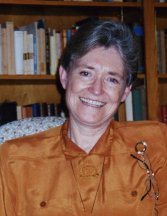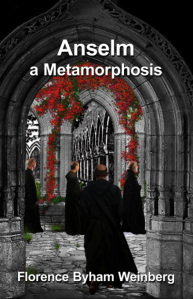Mayra Calvani's Blog - Posts Tagged "body-swap"
5 Questions with FLORENCE BYHAM WEINBERG
 Born in the high desert country, in Alamogordo, New Mexico, Florence loved exploring the wilderness on foot and horseback. Those grandiose landscapes formed her sensibility. Hidden pockets of unexpected greenery tucked away near springs in folds of barren mountainsides spoke to her of gentleness and beauty in an otherwise harsh world. She published her first poem in a children’s magazine shortly after she learned to read at age four; wrote her first ‘novel’ at age six, entitled Ywain, King of All Cats. She illustrated the ‘book’ herself.
Born in the high desert country, in Alamogordo, New Mexico, Florence loved exploring the wilderness on foot and horseback. Those grandiose landscapes formed her sensibility. Hidden pockets of unexpected greenery tucked away near springs in folds of barren mountainsides spoke to her of gentleness and beauty in an otherwise harsh world. She published her first poem in a children’s magazine shortly after she learned to read at age four; wrote her first ‘novel’ at age six, entitled Ywain, King of All Cats. She illustrated the ‘book’ herself.She traveled extensively with her military family during World War II. With her husband the brilliant scholar and teacher, Kurt Weinberg, she worked and traveled in Canada, Germany, France, and Spain. After earning her PhD, she taught for twenty-two years at St. John Fisher College in Rochester, NY, and for ten at Trinity University in San Antonio. She published four scholarly books, many articles and book reviews, doing research in the U.S. and abroad. When, after retiring in 1999, she was freed from academia to devote herself to writing fiction, she produced ten novels, ranging from fantasy to historical romance and mystery. An avid researcher, she grounds most of her publications in historical fact. She spends hours combing through web sites, books and periodicals, and historical archives to enhance her writings with authenticity.
Eight of her ten books are now in print: an historical romance about the French Renaissance, published in France in French translation by Editions Lyonnaises d’Art et d’Histoire, and two straight historical novels, Apache Lance, Franciscan Cross and Seven Cities of Mud. In addition, four historical mysteries starring the 18th-century Jesuit missionary, Father Ignaz (Ygnacio) Pfefferkorn. Two of these are set in the Sonora Desert, the third in an ancient monastery in Spain,and the fourth, Unrest in Eden, follows Pfefferkorn’s fate after his release from Spanish prison. Five of the historical novels have received a total of ten awards. Unrest in Eden is now published in German translation by Dr. Renate Scharffenberg under title Unruhe im Paradies.
The most recent book, Anselm, a Metamorphosis: metaphysical suspense , weaves an aura of black magic and nightmare that should fascinate all levels and ages of readers.
Florence also serves as Lector at Our Lady of Guadalupe Catholic Church in San Antonio, Texas, as well as appearing as a guest lecturer to various groups throughout the country and abroad.
Her favorite animals are horses-an intense love affair over many years-and cats, her constant companions. She enjoys music, traveling, hiking, biking, gardening, and swimming.
Website: www.florenceweinberg.com
Facebook: https://www.facebook.com/florence.weinberg.9
Twitter: htpps://twitter.com/floren4
Purchase the book on AMAZON
 Q: What’s inside the mind of a HISTORICAL FICTION/ FANTASY author?
Q: What’s inside the mind of a HISTORICAL FICTION/ FANTASY author?A: First, an off-the-wall idea, maybe inspired by something I read, maybe by a dream, maybe a movie. There must be a combination of an interesting time, a difficult and problematic situation, and an unusual protagonist. I, as author, must identify with the hero, otherwise the paranormal fantasy will not work. I must live the horrors of the hero’s fate so that the situation can come alive. I must feel his or her fear, frustration, and desperation. I must grope toward a solution to his impossible situation along with (or within) him, seeing everything from the inside outward, not as an omnipotent chess player. Often, the situation requires research as well, as in the case of a heart valve repair, or a believable Swiss topography. It must be something that strikes a universal note as, in this case, the wish “Gee, I wish I were in her/his shoes,” which could land the wisher in terrible trouble s/he knows not of.
Q: Tell us why readers should buy ANSELM, A METAMORPHOSIS.
A: Anselm is a departure from my normal writing, which is historical fiction and historical mystery. Everyone has had fantasies of being someone else. Christianity and most other world religions hold that the soul is real and separable from the body. This book asks, what might happen if a person were to wish to be someone, anyone, else and find that s/he really has become another person, while retaining her/his own mental identity? How would a person cope with that? This process of discovery of the hero’s new outer self and adjusting to his circumstances occupies a large portion of Anselm. Once the adjustment has been made—as best he can—then he tries to reverse the change. The pace is rapid, with something significant happening on each page.
Q: What makes a good FANTASY NOVEL?
A: In most cases, a good fantasy creates a parallel world (as in Tolkien or Oz) that resembles our own enough to be engaging, but which differs in wonderful ways. The hero is usually an innocent, a naïve person, who must discover the rules of the alternate world in time to avert disaster. In Anselm’s case, the worlds are real (university and monastery) but the circumstances of the body-exchange drive the action, first by discovering the new body and its capabilities, then by trying to find a way to “go home.”.
Q: What is a regular writing day like for you?
A: I rise at eight, breakfast, then spend several hours editing and adding to what I had written the day before. I have lunch, do any necessary errands or chores, then, after supper, continue writing until midnight. If on “a roll,” I might stay up until 2:00 AM. This is not a regular occurrence, however.
Q: What do you find most rewarding about being an author?
A: The greatest pleasure is in creating believable characters and seeing them in action in believable settings that I also create. My people are three-dimensional, think and talk like normal people (although occasionally, an anti-hero can get pretty extreme.) Also, the ability to create—in my case, as a historical novelist, recreate—a past reality. Anselm is the nearest thing to a contemporary novel that I’ve ever written. It is set, however, in the Viet Nam era—in the mid 1960’s. I needed a time when electronic media, especially cell phones, had not yet been invented.
Q: How did you celebrate the completion of your book?
A: I had a scotch on the rocks with a good friend and then went out to a gourmet restaurant and had a fine meal. I fear this wasn’t terribly imaginative! The conversation that evening was the best part.

Published on October 20, 2013 05:34
•
Tags:
benedictines, body-exchange, body-swap, fantasy, friedrich-nietzsche, geneseo, immanuel-kant, metaphysical-fantasy, metaphysical-suspense, mind-body-problem, monastery, ny-fiction, rené-descartes, rochester, sils-maria, st-anselm, st-moritz, suspense



